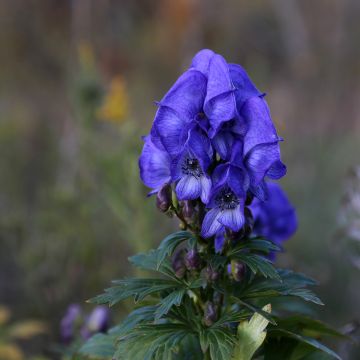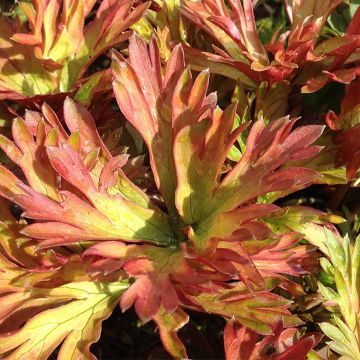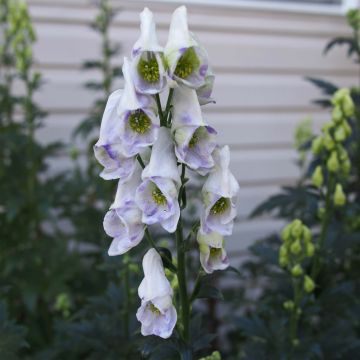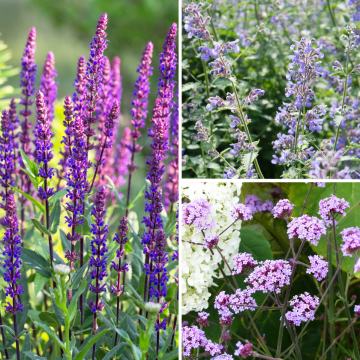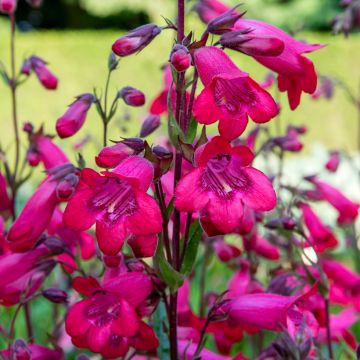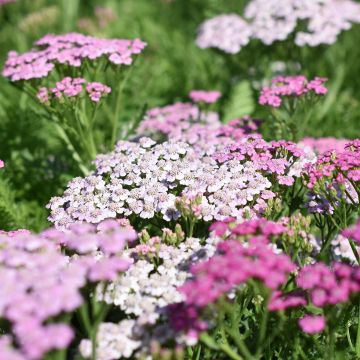

Aconitum hemsleyanum Red Wine
Aconitum hemsleyanum Red Wine
Aconitum hemsleyanum Red Wine
Climbing Monkshood, Hemsley's Monkshood
Why not try an alternative variety in stock?
View all →This plant carries a 12 months recovery warranty
More information
We guarantee the quality of our plants for a full growing cycle, and will replace at our expense any plant that fails to recover under normal climatic and planting conditions.
From €5.90 for pickup delivery and €6.90 for home delivery
Express home delivery from €8.90.
Does this plant fit my garden?
Set up your Plantfit profile →
Description
Aconitum hemsleyanum 'Red Wine' is a beautiful Burgundy-red flowering form of an astonishing climbing Aconite that is rarely seen in cultivation. This Chinese perennial produces voluble stems that are adorned in late summer with characteristic Jupiter's helmet-shaped flowers, whose wine-red colour is perfectly highlighted by pretty dark green palmate leaves reminiscent of maple leaves. You will install it in a cool and semi-shaded area of the garden, in humus-rich soil with a tendency towards acidity, on a trellis or among bushes that will provide support.
Originating from central and western China, where it is mainly found at the edge of forests, the Aconitum hemsleyanum is a climbing herbaceous perennial of the buttercup family, like its cousin Delphinium. The 'Red Wine' selection distinguishes itself from the species by the Burgundy-red colour of its flowers. This plant develops from a fleshy tuberous stump from which voluble stems emerge in spring and can reach up to approximately 2.40 metres (8 feet) by winding around the branches of neighbouring plants. These stems bear broadly triangular leaves, divided into 3 lobes with toothed edges. These leaves are shiny, with a dark green colour. In August-September, at the tips of the floral stems, spikes with up to 12 flowers bloom, topped by a large helmet-shaped petal taller than wide, whose substance wonderfully reflects the light. The hemsleyanum species, like all Aconites, is toxic in all its parts. The above-ground vegetation disappears in winter.
Aconites suffer from a bad reputation due to their legendary toxicity, which is a great pity because they have their place in all gardens, in moist to wet soil depending on the species. They are robust, very hardy, and their foliage is among the most beautiful among perennial plants. They are perfect in the background of flower beds, in the company of delphiniums, foxgloves, and baneberries, for enchanting shaded summer scenes. They can be planted among bushes, sheltered from the wind that sometimes bends their stems, in the company of Japanese anemones that will take over or accompany their flowering, depending on the varieties. Aconitum 'Red Wine', which prefers slightly acidic soils, will thrive alongside hydrangeas and Japanese azaleas. Its Burgundy flowers will be enhanced by the purple foliage of Physocarpus or Rodgersias. Like foxgloves, it is a good plant for light and cool woodlands.
Report an error about the product description
Aconitum hemsleyanum Red Wine in pictures


Flowering
Foliage
Plant habit
Safety measures
Botanical data
Aconitum
hemsleyanum
Red Wine
Ranunculaceae
Climbing Monkshood, Hemsley's Monkshood
China
ingestion
Cette plante est toxique si elle est ingérée volontairement ou involontairement.
Ne la plantez pas là où de jeunes enfants peuvent évoluer, et lavez-vous les mains après l'avoir manipulée.
Pensez à conserver l'étiquette de la plante, à la photographier ou à noter son nom, afin de faciliter le travail des professionnels de santé.
Davantage d'informations sur https://plantes-risque.info
Other Aconitum
Planting and care
Aconites thrive in light undergrowth or in morning sun, in a sheltered position away from strong winds. The climbing Aconitum 'Red Wine' will appreciate a deep, moist, humus-rich, acidic to neutral soil. It prefers partially shaded situations, but tolerates the sun, provided the soil remains consistently moist and never completely dries out. However, waterlogged soil in winter can harm its hardiness. It is recommended to use mulch in summer to maintain some freshness. The soil that welcomes it will be enriched with compost and turf, which will give it a slight acidity. Provide support for this climber, such as a trellis or bush. Attention, 'Red Wine' Aconite is toxic.
Planting period
Intended location
Care
This item has not been reviewed yet - be the first to leave a review about it.
Summer flowering perennials
Haven't found what you were looking for?
Hardiness is the lowest winter temperature a plant can endure without suffering serious damage or even dying. However, hardiness is affected by location (a sheltered area, such as a patio), protection (winter cover) and soil type (hardiness is improved by well-drained soil).

Photo Sharing Terms & Conditions
In order to encourage gardeners to interact and share their experiences, Promesse de fleurs offers various media enabling content to be uploaded onto its Site - in particular via the ‘Photo sharing’ module.
The User agrees to refrain from:
- Posting any content that is illegal, prejudicial, insulting, racist, inciteful to hatred, revisionist, contrary to public decency, that infringes on privacy or on the privacy rights of third parties, in particular the publicity rights of persons and goods, intellectual property rights, or the right to privacy.
- Submitting content on behalf of a third party;
- Impersonate the identity of a third party and/or publish any personal information about a third party;
In general, the User undertakes to refrain from any unethical behaviour.
All Content (in particular text, comments, files, images, photos, videos, creative works, etc.), which may be subject to property or intellectual property rights, image or other private rights, shall remain the property of the User, subject to the limited rights granted by the terms of the licence granted by Promesse de fleurs as stated below. Users are at liberty to publish or not to publish such Content on the Site, notably via the ‘Photo Sharing’ facility, and accept that this Content shall be made public and freely accessible, notably on the Internet.
Users further acknowledge, undertake to have ,and guarantee that they hold all necessary rights and permissions to publish such material on the Site, in particular with regard to the legislation in force pertaining to any privacy, property, intellectual property, image, or contractual rights, or rights of any other nature. By publishing such Content on the Site, Users acknowledge accepting full liability as publishers of the Content within the meaning of the law, and grant Promesse de fleurs, free of charge, an inclusive, worldwide licence for the said Content for the entire duration of its publication, including all reproduction, representation, up/downloading, displaying, performing, transmission, and storage rights.
Users also grant permission for their name to be linked to the Content and accept that this link may not always be made available.
By engaging in posting material, Users consent to their Content becoming automatically accessible on the Internet, in particular on other sites and/or blogs and/or web pages of the Promesse de fleurs site, including in particular social pages and the Promesse de fleurs catalogue.
Users may secure the removal of entrusted content free of charge by issuing a simple request via our contact form.
The flowering period indicated on our website applies to countries and regions located in USDA zone 8 (France, the United Kingdom, Ireland, the Netherlands, etc.)
It will vary according to where you live:
- In zones 9 to 10 (Italy, Spain, Greece, etc.), flowering will occur about 2 to 4 weeks earlier.
- In zones 6 to 7 (Germany, Poland, Slovenia, and lower mountainous regions), flowering will be delayed by 2 to 3 weeks.
- In zone 5 (Central Europe, Scandinavia), blooming will be delayed by 3 to 5 weeks.
In temperate climates, pruning of spring-flowering shrubs (forsythia, spireas, etc.) should be done just after flowering.
Pruning of summer-flowering shrubs (Indian Lilac, Perovskia, etc.) can be done in winter or spring.
In cold regions as well as with frost-sensitive plants, avoid pruning too early when severe frosts may still occur.
The planting period indicated on our website applies to countries and regions located in USDA zone 8 (France, United Kingdom, Ireland, Netherlands).
It will vary according to where you live:
- In Mediterranean zones (Marseille, Madrid, Milan, etc.), autumn and winter are the best planting periods.
- In continental zones (Strasbourg, Munich, Vienna, etc.), delay planting by 2 to 3 weeks in spring and bring it forward by 2 to 4 weeks in autumn.
- In mountainous regions (the Alps, Pyrenees, Carpathians, etc.), it is best to plant in late spring (May-June) or late summer (August-September).
The harvesting period indicated on our website applies to countries and regions in USDA zone 8 (France, England, Ireland, the Netherlands).
In colder areas (Scandinavia, Poland, Austria...) fruit and vegetable harvests are likely to be delayed by 3-4 weeks.
In warmer areas (Italy, Spain, Greece, etc.), harvesting will probably take place earlier, depending on weather conditions.
The sowing periods indicated on our website apply to countries and regions within USDA Zone 8 (France, UK, Ireland, Netherlands).
In colder areas (Scandinavia, Poland, Austria...), delay any outdoor sowing by 3-4 weeks, or sow under glass.
In warmer climes (Italy, Spain, Greece, etc.), bring outdoor sowing forward by a few weeks.



































